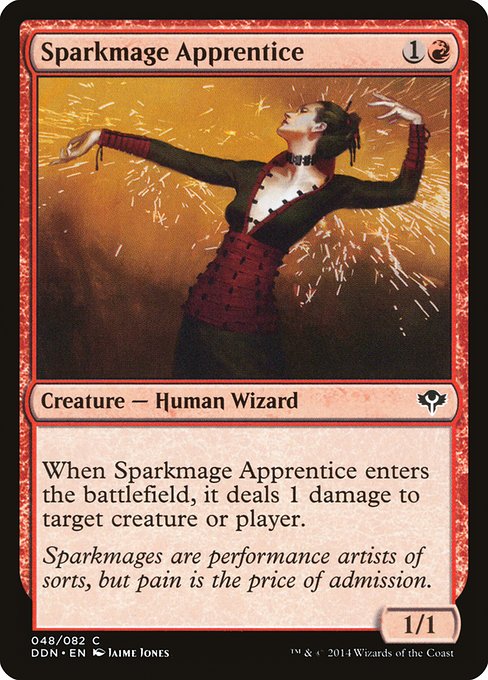
Image courtesy of Scryfall.com
Breaking the Fourth Wall in MTG Design
Magic: The Gathering has always thrived on a little magic inside the card—flavor text, worldbuilding, and clever mechanical twists that make you pause and smile. When a card feels like it’s addressing you directly, you glimpse that magical boundary between player and game, and the break can be delightfully refreshing. Sparkmage Apprentice is a neat, compact example from a 2014 Duel Deck that embodies this playful candidness. It’s a small creature with a big personality, a reminder that red’s playground sometimes includes not just raw power but a wink to the audience 🧙♂️🔥.
A tiny burst of stagecraft on a common card
From the moment you pay {1}{R} for a 1/1 Human Wizard, you’re met with a moment that speaks to the audience in the stadium of your table. When Sparkmage Apprentice enters the battlefield, it immediately deals 1 damage to any target, a direct line to a player, a creature, or even a planeswalker that dares stand in its spotlight. That quick trigger is not just a tempo play; it’s a miniature performance—the card takes the stage, delivers a line, and steps off as the audience roars. This is red design at its most theatrical: simple, direct, and a little bit reckless in service of the show 🔥⚔️.
In the broader design conversation, this is a reminder that entry effects can be used to create a sense of agency and immediacy. The damage isn’t reserved for the opponent’s life total alone; it can pressure a tapped blocker, whittle down a troublesome planeswalker, or simply remind both players that the stage is a shared space where every entrance has consequences. The flavor text about sparkmages as “performance artists” reinforces that idea—they bring the smoke and mirrors, and sometimes the price of admission is a little collateral damage 🎨🎲.
Flavor vs. function: how fourth-wall touches land in MTG
- Flavor alignment: The flavor text, artisty ambiance, and the “enter the battlefield” moment all reinforce the idea that sparks are spectacles. The card invites players to imagine the onlookers and the reaction to a sudden burst of flame—not merely a computed stat line.
- Mechanical clarity: The ability is straightforward and unambiguous. The phrase “When this creature enters, it deals 1 damage to any target” is rules-clear and instantly understandable, which is essential for a fourth-wall moment to land without confusing players or slowing the game down.
- Audience-aware design: The card’s premises play with the idea that you’re controlling a troupe of spark-wielding wizards. The “any target” clause gives you room to surprise your opponent or to protect your board, reinforcing that the spectacle can be directed at many ends, not just raw aggression 🔎.
Design patterns that invite audience-facing moments
If you’re a designer aiming to thread fourth-wall cues into MTG, consider these patterns that Sparkmage Apprentice helps illuminate:
- Direct, time-limited effects: Enter-the-battlefield triggers create a crisp, one-shot moment people remember. It’s theatre in miniature—stop the clock, deliver the line, and watch the reaction.
- Narrative voice through flavor text: Flavor lines can hint at a meta-level rapport between card and player, nudging folks to see the card as a performer rather than a mere stat line.
- Playable self-awareness: Cards that acknowledge the audience or the act of playing (without breaking game clarity) can heighten immersion while maintaining balance.
- Controlled risk: The effect is small but persistent in red’s wheelhouse—fast pace, small payoffs, and the occasional big swing. A good fourth-wall moment respects the player’s agency without hijacking the game's learning that it’s a fair fight 🧙♂️.
Strategic takeaways for players and deck builders
For players, Sparkmage Apprentice is a reminder that tempo and value aren’t always about bigger creatures or bigger spells. In aggressive red shells, a 2-mana 1/1 with an on-entry ping can help you tip a race in your favor, pressure a planeswalker, or set up a future burn plan. In more casual or themed builds, it serves as a talking point for how a card’s “speech” can echo the pilot’s intentions—rapid, flashy, and a touch reckless 💎⚔️.
For deck designers and casual fans chasing flavor-first themes, this kind of card proves you don’t need a grand mechanical revolution to make a meaningful impression. You can plant a motive in a small moment and let it resonate through your table—turning a simple 1-damage line into a shared, story-rich beat in the game’s ongoing narrative. The result is a more memorable experience, where strategy and theater can coexist as peers rather than strangers 🧙♂️🎨.
Where to look next and how to apply the spark
If you’re curious to explore more cards that balance flavor, utility, and a bit of fourth-wall flair, start by examining how entry triggers frame turn-by-turn decisions. Consider your own playgroups' sense of humor and tension: do you want a card that quietly nods to the audience, or one that grabs them by the lapels and yells a playful taunt? Either path can enrich the table, so long as clarity and balance stay in play 🔥🎲.
And as your desk becomes a stage for these moments, you might want to upgrade the backstage area with a neon glow. The right playmat can set the vibe as you stage your next match—the kind of item that feels like a prop from a favorite show while staying perfectly practical for real play. Speaking of props, the neon mouse pad in the product link below is the kind of desk companion that complements a high-energy, narratively charged session 🧙♂️💎.